In the 2000s, home cinema became universally recognised. Although the 5.1 and its modest number of speakers had attracted a large following, the regular addition of new channels put a brake on its development. Fewer and fewer people were willing to install 7, 9 or 11 speakers in their living room. A solution was needed and it came from the manufacturers of multi-channel audio/video amplifiers such as Pioneer and Yamaha: the sound projector. A kind of single speaker bringing together all the channels needed for Dolby and DTS.
Initially dedicated solely to home cinema, over time soundbars have added more functions. They have become true audiovisual management centres, comfortably handling both films and music. Bluetooth and WiFi have become the two channels enabling soundbars to act as audio systems. Used this way, they function as wireless speakers would. As for the HiFi companies, some of them have entered this niche market, mainly from a musical point of view, with fewer functions. Centred more towards sound quality, they perform a little less well as home cinema systems, although they provide the basic functions in this domain. There are also multi-purpose bars, which we will cover for you in this selection.
1. TCL TS8111: a good starter soundbar
Price : 199 €
Features : 260 Watts, 2.1, 8x speakers, Bluetooth, 1x HDMI eARC, 1x HDMI input, 1x optical, 1x 3.5 mm mini jack, IR remote control, 1000 x 65 x 128 mm, 2.9 kg
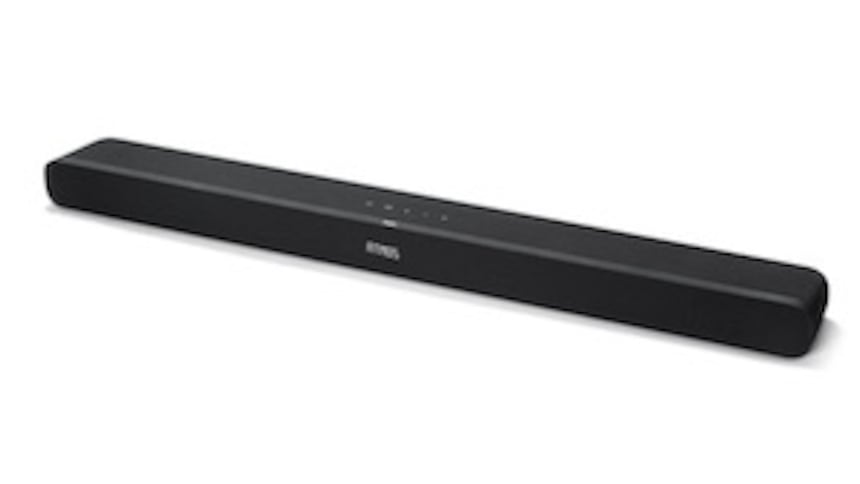
TCL offers essentially entry level soundbars, in classic dimensions. The TS8111 is one of the most accessible and simplest to use. It reproduces the bass frequencies itself which is one of its best qualities. The sound signature is harmonious, making it an excellent choice for both film and music use.
In this price range, a WiFi connection is not offered. You have to make do with Bluetooth, unless you use an audio playback application on a connected TV, or a multimedia box connected by HDMI cable. The front display panel is a welcome feature showing the current status of the bar at any time.
Pros :
Pleasant sound signature
Easy to operate
Front display panel
Cons :
Basic design
No WiFi
2. Harman Kardon Citation MultiBeam 700: the soundbar with the best finish
Price : 499 €
Features : 210 Watts, 5.0, 7x speakers, Bluetooth, WiFi, 1x HDMI ARC, 1x optical, 1x 3.5 mm mini jack, Chromecast, AirPlay 2, Google Assistant, 790 x 65 x 130 mm, 3.7 kg
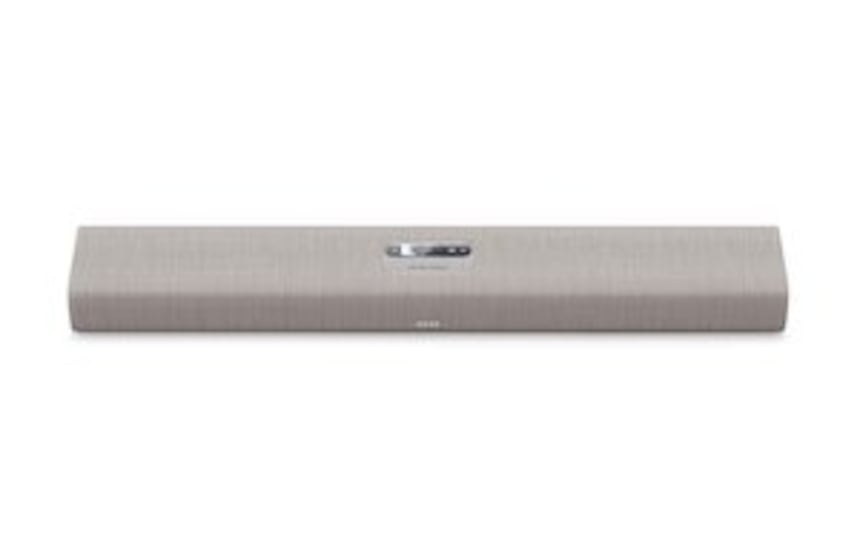
Within the extensive range of Harman Kardon Citation connected devices, the MultiBeam 700 is a standout amongst other soundbars. The 700 is an all-in-one, well-equipped, intermediate model. The design is decidedly premium with Kvadrat fabric, soft shapes and a colour touch screen. The drawback is that when mounted on the top, it is not visible when you are sitting down.
The MultiBeam 700 provides quality performance in terms of musicality. The sound is warm with generous bass despite the absence of a separate subwoofer. Audio and home cinema modes are limited. It offers both, but we prefer it for listening to music, which is a nice change from the usual wireless speakers.
Pros :
The finish
Connectivity
Sound quality
Cons :
Top mounted screen is not practical
3. LG Eclair QP5: the best size/sound level combination
Price : 599 € (est.)
Features : 320 Watts, 3.1.2, 7x speakers, Bluetooth, 1x HDMI eARC, 1x HDMI input, 1x optical, 1x 3.5 mm mini jack, IR remote control, 296 x 59.9 x 126 mm, 1.55 kg

LG is moving towards creating a new category of soundbar: the mini soundbar. This QPS is a mere 29.6 cm wide. Finding space for it is child's play, even with the smallest TV stand. Although it is compatible with immersive cinema audio modes, the sound stage is still mostly centred around the bar. However, the magnitude is huge, achieving its objective.
Connecting this bar with very large screens is no problem. The subwoofer works on the principle of vibration cancellation to produce a sharper, less localised sound. Properly positioned in the room, this connected ensemble shows qualities that are eminently suitable for listening to music, and all with a minimal space required.
Pros:
Mini format
Adequate wired connectivity
Fullness of sound
Cons:
Average ergonomics
No WiFi
4. Yamaha MusicCast BAR 400: the soundbar delivering the best compromise
Price : 599 €
Features : 200 Watts, 2.1, 8x speakers, Bluetooth, WiFi, Ethernet, 1x HDMI ARC, 1x optical, 1x 3.5 mm mini jack, AirPlay 2, IR remote control, 980 x 60 x 110 mm, 2.7 kg
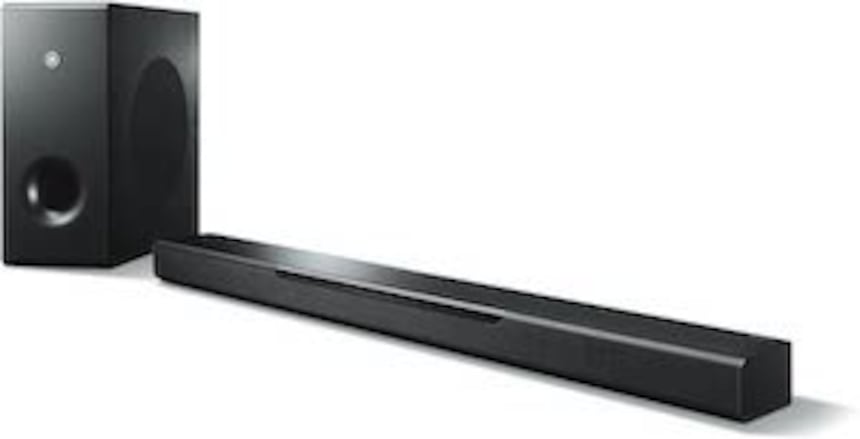
Yamaha is one of the leading instigators of this category of speakers. The MusicCast BAR400 is the almost ideal compromise in a field that spans a wide price range. This bar comes with its own subwoofer and it can be optionally connected to one or two additional surround speakers.
As the name MusicCast implies, it connects via this wireless audio distribution protocol. So Qobuz is directly integrated in the remote control application. Traditionally, Yamaha devices come equipped with multiple sound modes offering a choice of effects and immersion. These can be used for listening to music, seeming to push the walls back for even more sound presence.
Pros :
Immersive sound modes
Qobuz integrated
Connectivity
Cons :
The remote control ergonimics
No YPAO calibration
5. Dali Katch One: the simple and effective soundbar
Price : 749 €
Features : 200 Watts, 2.1, 10x speakers, Bluetooth, 1x HDMI ARC, 2x optical, 1x 3.5 mm mini jack, IR remote control, 860 x 164 x 69 mm, 3.7 kg
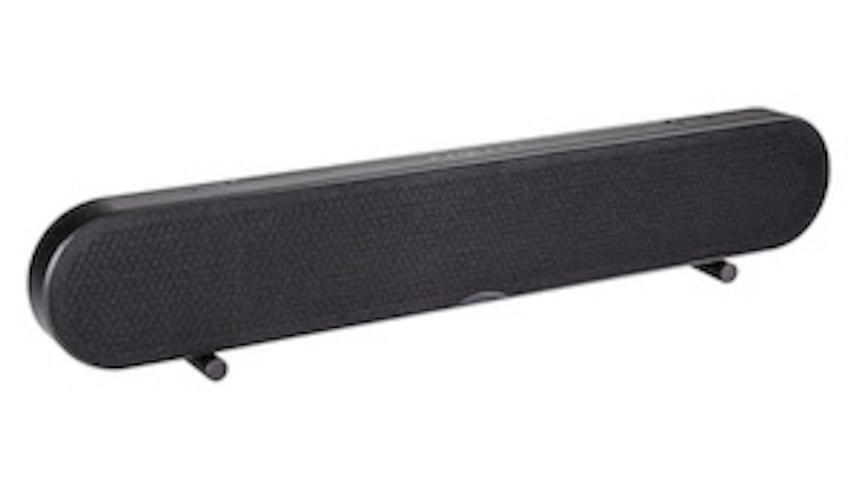
Better known for its numerous series of passive and amplified HiFi speakers, Dali is represented here in the soundbar world by the Katch One. This speaker stands out from its competitors by its shape: rounded edges, a large front panel and leather straps for wall mounting. Connectivity is interesting with four separate inputs.
Leaning more towards HiFi, the Katch One works in stereo. The bass is reinforced by four passive radiators. Two sound modes are offered. Dali applies well thought out digital processing with its Wide mode. The music fills the room in a natural way, as if you were facing a pair of speakers. The leave-on mode works very well regardless of what you use the bar for.
Pros :
Original appearance
"Wide" mode is a great success
4 audio inputs
Cons :
No WiFi
No modern multi-channel support
6. Sonos Arc: the most evolved soundbar
Price : 899 €
Features : power output - not available, 5.1.2, 8x speakers, WiFi, Ethernet, 1x HDMI eARC, AirPlay 2, Amazon Alexa, Google Assistant, 1141 x 87 x 115 mm, 6.25 kg
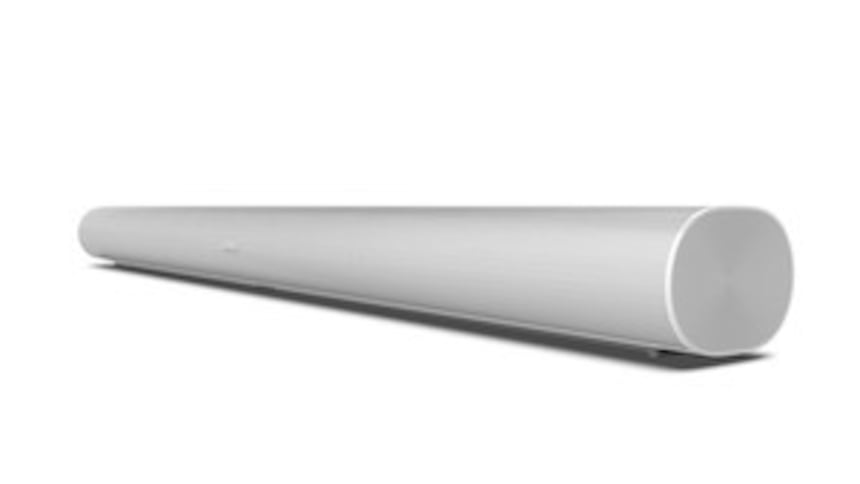
The latest addition to the Sonos series of mainly home cinema speakers, the Arc bar is a Sonos speaker like any other. It enjoys the same wireless audio playback capabilities, with native Qobuz integration. It can be included in a multi-room system, and a separate subwoofer and surround speakers may be added, as there are many compatible models.
This large Dolby Atmos-compatible soundbar has no audio settings other than Sonos Trueplay auto-calibration. That aside, the bar uses its full range of speakers in all programmes, producing wide, open listening. The dynamic bass is satisfactory in most cases. Voices are clearly detached from the rest of the sound message, one of the major qualities of this bar.
Pros:
Simple to use
Qobuz integrated
Quality of voice reproduction
Cons :
Large size
Only one audio mode
7. Philips Fidelio B97: the champion soundbar of immersive 3D
Price : 999 €
Features : 888 Watts, 7.1.2, 15x speakers, Bluetooth, WiFi, 1x HDMI eARC, 2x HDMI inputs, 1x optical, 1x 3.5 mm mini jack, Chromecast, AirPlay 2, DTS Play-Fi, IR remote control, 1312 x 55.6 x 120 mm, 7 kg
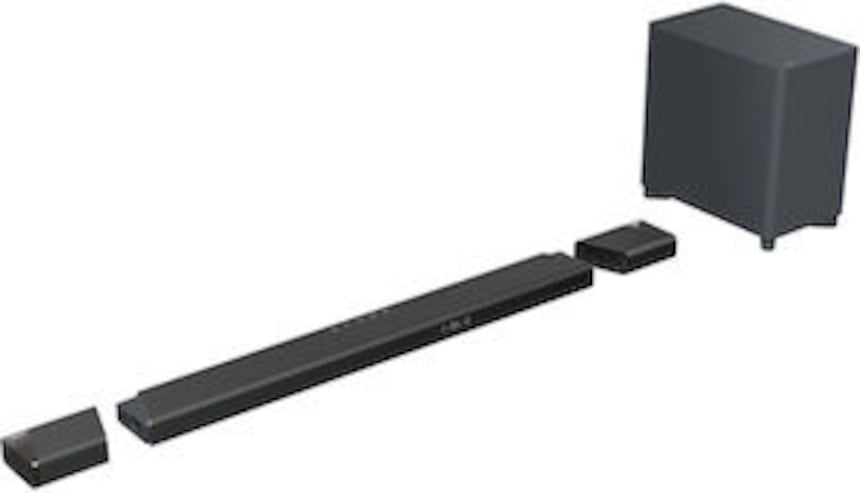
The Fidelio B97 takes you to the top of the soundbar range. It is unique in the way that it comes with two battery-powered surround speakers that can be recharged by clipping onto the ends of the bar. As for connectivity, Philips is pulling out all the stops with AirPlay 2, Chromecast and DTS Play-Fi. Everything is in place for easy Qobuz listening.
The B97 is one of the most immersive soundbars available at any price. It has the ability to diffuse sound at 360° into the room, with sound effects in all three dimensions. Different modes and an equaliser allow you to adapt the sound to your preferences. Distributing the sound to all the speakers while listening to music puts you in the centre of the sound stage. Although not a faithful reproduction, listening in this way is quite exhilarating.
Pros :
3D effect
Networked audio protocols
Battery powered surround speakers
Cons :
Recessed subwoofer
Flashy finish
8. Bluesound Pulse Soundbar+: the most adaptable soundbar for cinema and music
Price : 999 € (1099 € in white)
Features : 120 Watts, 2.0, 8x speakers, Bluetooth, WiFi, Ethernet, 1x HDMI eARC, 1x optical, 1x 3.5 mm mini jack. AirPlay 2, 1073 x 141 x 70 mm, 6.8 kg
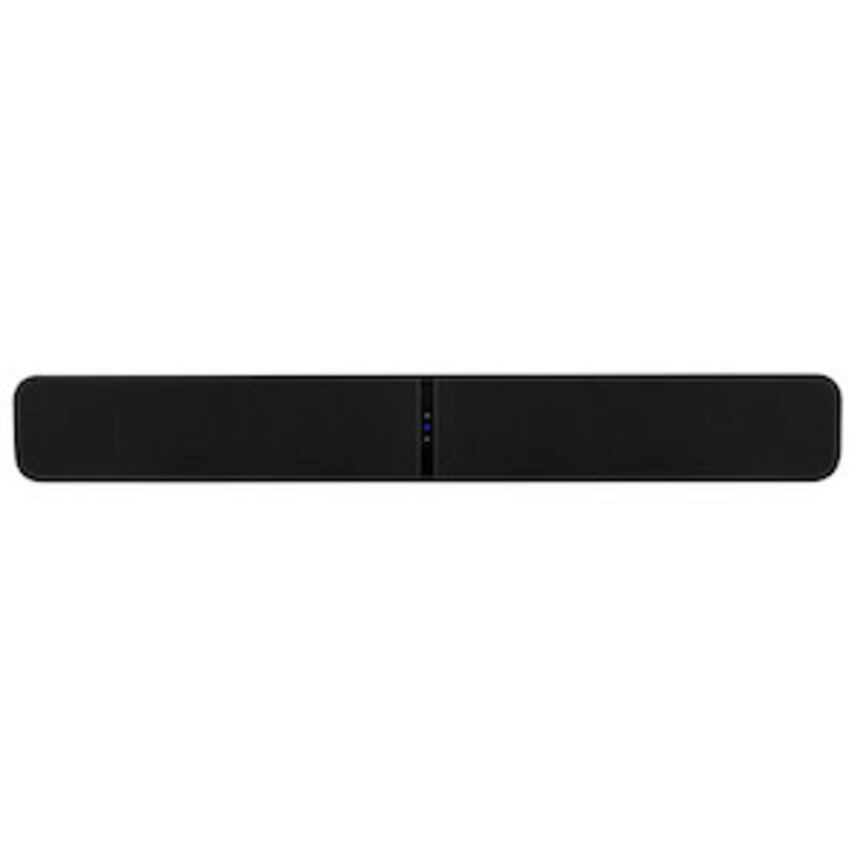
Bluesound's connected range is built around a few specific products designed to meet all requirements, so there is this soundbar for mixed use, the Pulse Soundbar+. This is the latest version, updated with two additional speakers to improve low-frequency reproduction. Dolby Atmos compatible, it can be complemented with surround speakers and a wired or wireless subwoofer.
The tonal quality of this bar is its greatest asset. The sound spreads smoothly from the bar to create a wide and pleasant sound stage. With its powerful bass you can do without a subwoofer. Hi-Res Qobuz is natively available thanks to its BluOS mobile application. An interesting alternative to a small pair of bookshelf speakers.
Pros :
Quality of tone
Breadth of the sound stage
Qobuz integrated
Cons :
Limited sound modes
More expensive in white than black
9. Samsung HW-Q950A: the ultimate soundbar
Price : 1 499 €
Features : 616 Watts, 11.1.4, 22x speakers, Bluetooth, 1x HDMI eARC, 2x HDMI inputs, 1x optical, IR remote, AirPlay 2, SmartThings, 1232 x 69.5 x 138 mm, 7.1 kg
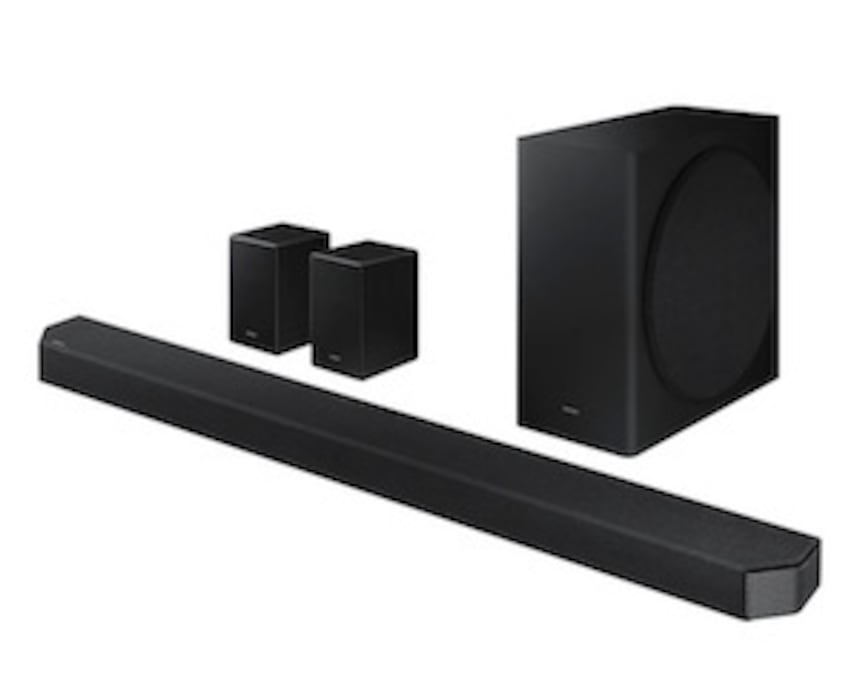
The Samsung HW-Q950A is the ultimate stage before moving to a conventional home cinema system with separate speakers. The Q950A is the only 11.1.4 compatible soundbar. It has enough speakers projecting in all directions to faithfully reproduce Dolby Atmos and DTS:X soundtracks. All this with just four components: the bar, two wireless surround speakers and a massive subwoofer.
Apart from room-filling sound effects that reach the ceiling, the Q950A is capable of shaking the walls with its powerful subwoofer. This system is intended for comfortably sized rooms. For music, the adaptive audio mode makes the most of your recordings and reproduces them in a natural way, with a bass that's always present. It tackles even the largest living rooms.
Pros:
Music can fill large rumes
True sound for home cinema
Connectivity
Cons :
High price
Large size
10. Bang & Olufsen Beosound Stage: the benchmark for all-in-one soundbars
Price : 1 500 €
Features : 550 Watts, 3.1.2, 11x speakers, Bluetooth, 1x HDMI eARC, 1x HDMI input, 1x 3.5 mm mini jack, AirPlay 2, Chromecast, 1100 x 170 x 77 mm, 8 kg
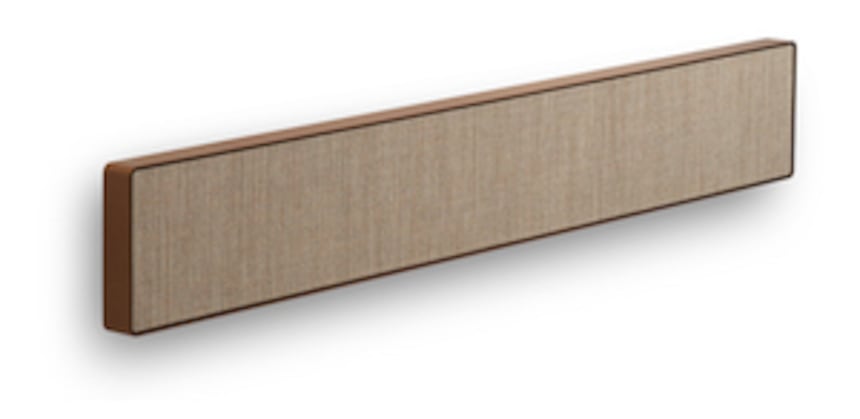
The Beosound Stage is the flagship soundbar from Bang & Olufsen. The Danish manufacturer has chosen to take the minimalist route with an all-in-one speaker, without the option to add a subwoofer or surround speakers. It has been designed to be used on its own, to accompany a TV in the living room, or even as a discreet wireless speaker on a bedroom or office wall.
The on-board speakers achieve that aim. The tones are respected and the bandwidth is the widest you will find on a soundbar. The bass quality is astonishing in such a compact unit. The Beosound Stage takes full advantage of its HDMI socket, its network connectivity for music and the B&O application to select custom sound settings.
Pros :
Ultra wide bandwidth
Immersive sound
Multiple audio settings
Cons :
Limited wire connectivity
The special finishes push up the price
Conclusion
The soundbar is becoming the new HiFi system. Its components have become able to compete with a small pair of bookshelf speakers, as well as most current wireless speakers. The bars have the additional advantage of reproducing film soundtracks. However, there is nothing to stop you using your soundbar in audio mode only, without connecting it to a TV. Their wide format and wall-mounting options can provide creative mounting ideas. As is often the case, the higher up the range, the better the sound quality. In contrast, the entry-level models have the advantage of being compact and all-in-one. This is also shared with the more HiFi soundbars such as Dali, Bluesound and Bang & Olufsen. The other important point when choosing a soundbar is connectivity. Apart from Bluetooth, which is included on almost all models, a WiFi link opens the door to dematerialised music and music services. These latter are not always integrated, but the AirPlay 2 and Chromecast protocols often replace them to advantage for universal use. Finally, we’ll finish with the design. Some manufacturers are working on materials and colours to offer premium bars worthy of the most attractive connected speakers, and thus will be better adapted to your taste in terms of decor.